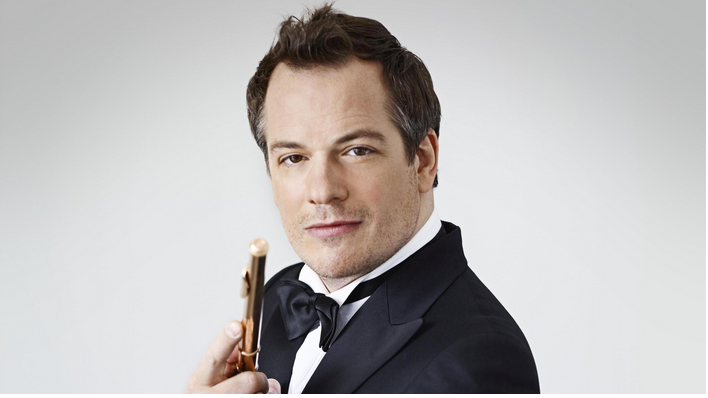by Kevin McLaughlin

Pahud, the longtime principal flutist of the Berlin Philharmonic and something of a rock star in the flute world, received a Beatles-like reception from the many flute students in attendance. There were shrieks of excitement and standing ovations, and at intermission an extended period of selfie-taking and high fives with the star.
Established and new works by J.S. Bach and Nicolas Bacri were featured, as well as transcriptions of violin pieces by Mozart, Clara Schumann, and César Franck by Pahud.
First was Mozart’s Violin Sonata No. 21 in e — in a minor key! During a difficult trip to Paris in 1778 the composer’s mother, Anna Maria, unexpectedly passed away. Following an opening piano statement Pahud entered on the same eerie melody, made eerier by the flute timbre. Both soloist and pianist were in sync throughout, shaping melodic lines, and conveying its romantic character. Indeed, Pahud’s feat as a transcriber was to make something familiar and classical appear beguiling, almost exotic.
Bach’s Flute Sonata in b, BWV 1030, was elegantly played, with a lovely soft legato from Pahud supported by clean, energetic accompaniment from Bax. The opening movement had a satisfying sense of pulse that brought clarity and shape, and the Largo movement flowed with a sense of momentum tastefully enhanced by rubato. The final Presto was quick but judiciously so, with Pahud’s suave articulation retaining tasteful Baroque style.
Unfamiliar to this listener was Nicolas Bacri’s Sonata no. 3 op. 156, an homage to French flutist Jean Pierre Rampal and to French flute style itself. Though the musical language and gestures may be more reminiscent than novel, Pahud’s sweeping and bravura performance underscored it as a new work. Pahud reveled in every reference and derivation of this four-movement work: the Henri Dutilleux tribute in movement one, a Debussy Syrinx-like cadenza, the lovely Jolivet-reminiscent canzona in movement three, and top speed hijinks in a finale that sounded a lot like Francis Poulenc.
There’s no lack of performances of Robert Schumann’s Three Romances, so how nice to hear Clara Schumann’s identically named op. 22, especially in Pahud’s recent transcription. Well-coordinated chamber playing was in evidence, and at times the two instrumentalists seemed more like storytellers or folksingers. In the first Romani-inspired movement, and the last (marked Leidenschaftlich schnell — Passionately fast) you could almost hear the words of the Romance.
On a side note: What expressive feet Pahud has — constantly lifting and stepping like a fidgety ballet dancer.
Though Franck’s Violin Sonata is favored by this listener in its original form, Pahud’s arrangement made a credible case for a flute transcription. The range and volume of the flute isn’t as great as that of the violin, so the soloist is required to make some accommodations — playing notes an octave higher or leaving out harmonies of double or triple stops, pacing the climaxes, etc. But in the end, there are elements of the flute version that make the work seem fresh.
Pahud and Bax managed to make up for violin fervor with marvelously matched sweetness (what a velvety tone Pahud has, especially in the lowest register), a diabolical churning, as well as well-timed musical climaxes. Pahud’s articulation was itself a wonder — elfin and agile —especially in the tricky third movement. In the canonic finale, Pahud’s sensuous sound was used as a loudness emulsifier and a distinct, expressive element.
The audience was eager for an encore, and they got it in a lovely performance of Gabriel Fauré’s Sicilienne.
Published on ClevelandClassical.com January 30, 2025
Click here for a printable copy of this article


